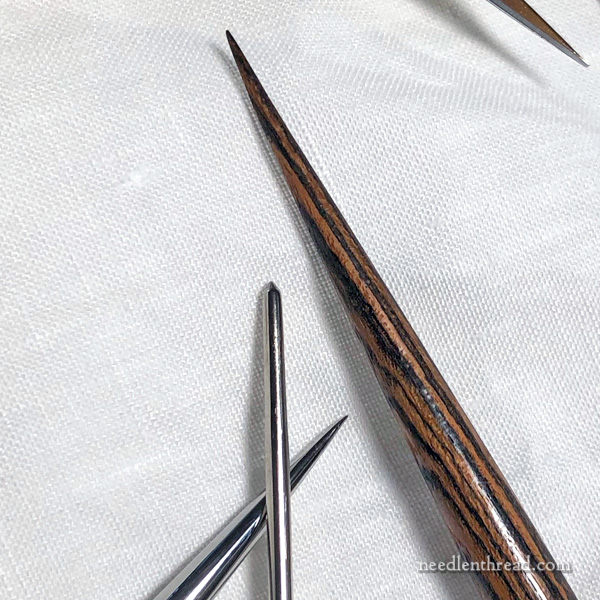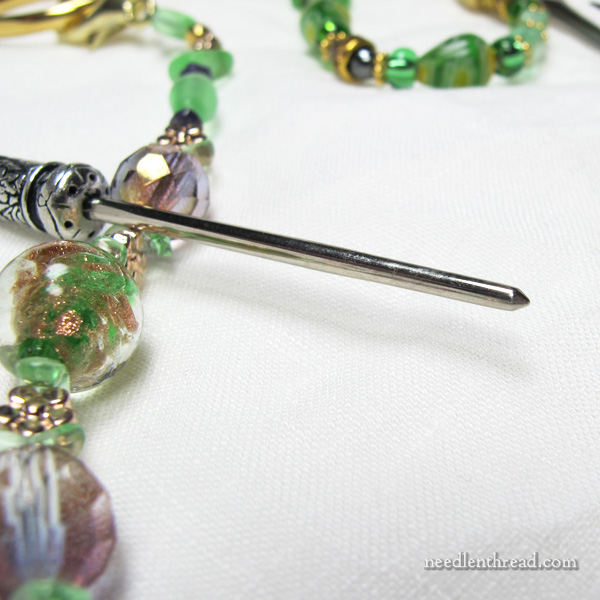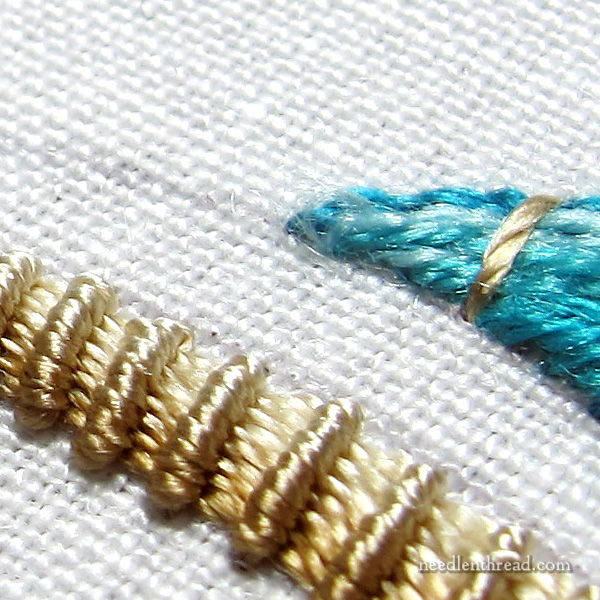She’s a dull tool.
It’s not a very nice thing to say about a person.
But sometimes, believe it or not, it’s a great thing to say about an embroidery tool!
Today, I’ll present a case wherein the dull tool is the highly desired tool. I’ll explain…

The dull tool I’m talking about today is the blunt-tipped laying tool.
If you’re not familiar with a laying tool and how it is used in hand embroidery, you might take a look at this video showing a laying tool in use and read the accompanying article. This will give you a little background on the laying tool.
In a nutshell, a laying tool (called a “tekobari” in Japanese embroidery) is a tool to help you lay your threads so that they are smooth and parallel to each other, or so that the stitch is placed how you want it.
The tool is often used with satin stitch, cross stitch, tent stitch, and other stitches when more than one strand of thread is used in the needle and it is desirable to place the stitch without the strands twisting around themselves.
But for many embroiderers, the laying tool is also used to control the embroidery thread. Often, when stitching with particular types of thread, the thread can be cranky and twisty, boingy and bouncy, and in many ways problematic … or just downright annoying. A laying tool helps hold the thread under a little tension while it is pulled through the fabric, so that you can place the stitch exactly where you want it and how you want it while keeping a cantankerous working thread under control.
Laying tools come in all shapes and sizes and they can serve other needlework-related purposes, too. A stiletto or awl, for example, can be used as a laying tool, but they can also be used for boring a hole into fabric. A tapered awl or stiletto will push the threads of fabric apart to form a larger hole.

I have a lot of laying tools. The tools above are examples of those that I use pretty regularly.
All of them, save one, have very sharp tips. If you jabbed them into yourself accidentally, they could cause damage!
But one them – one delightful laying tool – has a dull or blunt tip. And it is a fabulous feature!

On this blunt-tipped laying tool, notice the very shallow taper and the rounded finish at the point.
The tool has a long, thin, non-tapering shaft and a decorative pewter handle that’s slightly longer than the shaft. The whole tool is about 4.5″ long. The handle has a nice weight to it, and it’s comfortable to hold.

This particular tool comes from Coleshill Collection, a company in the UK that, among many other embroidery-related things, produces pewter-handled, Victorian-esque embroidery tools. The blunt-tipped laying tool is this one. (If you browse through the site, you’ll also find matching scissors and other accessories.)
You can also inquire at locally-owned, small needlework shops to see if they carry a blunt-tipped laying tool. For those who don’t have a local shop, ask your favorite locally-owned shop with an online presence.
So, why do I advocate owning a blunt-tipped laying tool?

See the fuzzy tip on the blue silk in the photo above?
I grabbed the closest laying tool while I was stitching, and it didn’t have a blunt tip. I told myself, “You should switch tools…” but then, being the lazy clod that I can often be, I didn’t bother.
And sure enough, the next thing I knew, the sharp tip of the laying tool that I was using snagged right across the surface of those threads and pulled them all out fuzzy.
You can save yourself so much frustration if you use the right tool for the job.
In this case, the blunt-tipped laying tool would have been the right laying tool to use, and it would have saved me from the frustration of having to fix the fuzzies on that area of embroidery.
So that’s why I think a blunt-tipped laying tool is a great tool to have on hand, and why I recommend adding one to your embroidery tool box!
You’ll be glad you did!







I recently bought a Tim Holtz retractable craft pick at my local hobby store to keep in my stitching bag. It works pretty well as a laying tool and doesn’t do damage in my bag.
Tonic Studios Tim Holtz 372 Retractable Craft Pick
Great column as always, Mary! I was wondering what your thoughts were on the trolley needle. As you note, “use the right tool for the job,” so it wouldn’t work in every instance. But I find I’m relying on it a lot in cross-stitch to keep my two threads from twisting. Using it as an extension of my finger instead of holding the separate laying tool seems easier to me.
I have a trolly needle, but gosh, I have the worst time getting used to it. Once I get used to it – if I’ve used it for several days in a row – it’s easier to think of it as an extension of my finger, but in the meantime, I tend to almost poke my eyes out. I prefer the length on a laying tool, so I can keep my hand that controls it farther away from the work. I can see better to manipulate threads that way. Because I stitch with my work fairly close to my face, I find it handy to have a little more length to the laying tool.
Mary, I’m in full agreement. With canvaswork, I’m often using multiple strands, or fibers such as narrow ribbons or tubular nylon. I have several laying tools, and tend to use the blunt ones unless I absolutely need the precision of a sharp tip. I have a scissors block with four holes. My usual arrangement is embroidery scissors, sharp laying tool, blunt laying tool, and a lift’n’snip scissors (straight blade with the little cut-out).
One question — have any suggestions for “fixing” the tip of a sharp laying tool if it is catching a lot on threads?
Hi, Joanne – I’ll show you how I fixed it in my next update on this project. I think (I hope?!) I took a photo…
Where can one purchase a Best Laying Tool?
Love this article! It explains so much! Also, can I ask how you accomplished the gold stitch in the bottom left of the photo? I don’t recognize that one and it’s quite pretty!
It’s a ribbed stitch – like the ribbed spurred web, only not worked around, but in a line. 🙂
Huh! Ribbed stitch. I did not guess that one. Now I have to go try it out. It’s very pretty, especially in the gold! Thanks! 🙂
It’s a fun stitch, Sheila, and pretty darned quick! You just lay the foundation bars, and then pretty much just backstitch over them… I like it especially when working with Silk Perlee in graduated shades. It makes for a nice “ombre” effect.
I have a stiletto that has a shape like that at the end. Never thought of using it as a laying tool. How did you fix your fuzzies? I wonder if my snag dab it would take the fuzzies to the back side-another tool I enjoy when the occasion calls for it.
I’ll probably talk about that in my next project update! 🙂
For those who want a blunt-tipped laying tool for minimal expense, I recommend a knitter’s cable needle. Not beautiful, but it lays thread, rounds out eyelets and is generally good for assorted prodding and poking jobs. Plus, if you lose it, it doesn’t break your heart.
Excellent suggestion!
I have ALWAYS had a few #13 tapestry needles (sometimes called “weaving needles”) around for this exact purpose. And they are extremely valuable for ribbon embroidery — doesn’t snag the ribbons! In fact, I give one with each class-kit when teaching. There is even a “weaving needle” with a bent point, when one can find one, that works very well. For gluing….. holding things in place….. I could go on!! I just have never noticed a fancy one like you show in the blog! I must pay attention! thank you!
I do, too, Bobbie – but sometimes, needles aren’t long enough. The advantage of a longer laying tool over a needle is that you can keep your other hand completely away from the work while manipulating the thread and the laying tool. Helps me see better, especially because my face is usually pretty close to my work.